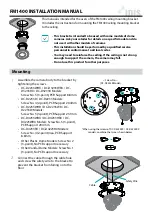
27
Installation & Operation Guide: Oncam Grandeye 360
o
Evolution Camera Range
Version 2.4 | January 2014 | Oncam Grandeye, 115 Hammersmith Road, London. W14 0QH. UK
T: +44 (0)20 7371 6640 | E: [email protected] | W: www.oncamgrandeye.com
Connect the network cable (RJ45) and the alarm input / output / alarm reset cable to the camera module along with
the remote microphone if this is being used. If the device is not being powered via PoE IEEE 802.3af through the
Ethernet cable, use only a UL/CSA
‐
approved LPS or NEC Class 2 power source with a 12V DC 1A AC adapter (not
supplied), this must have a wired plug connector with the correct polarity (+ve center).
The camera can now be powered.
A BNC connection has been supplied for local testing and could be used to
feed a fisheye image to a spot monitor. Connect a suitable PAL or NTSC
composite video test monitor to view the live “Fish Eye” image from the
Camera Module. By selecting DIP switch #2, to either (1-on) PAL or (0-off)
NTSC analogue video can be viewed.
This signal can also be routed to a permanent “spot” monitor if desired.
The focus is set at the factory so no adjustment is necessary.
Carefully re
‐
seat the dome trim ring, taking care not to damage the dome surface, and
ensuring that the dome seal is retained correctly.
•
Outdoor Dome Camera - Refit the dome screws with the supplied Torx driver, and tighten to ensure
ingress protection is maintained around the dome seal.
•
Indoor Camera – align the dome trim ring over the base plate so the retaining clips align correctly to allow
the trim ring to clip in to place.
Remove the screen protection film from the dome. Carefully polish the Surface of the dome with a soft, lint
‐
free,
nonabrasive cloth to complete the installation.
















































